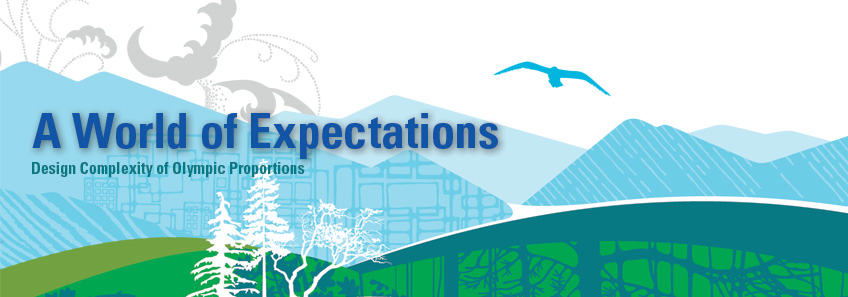
Vanoc Design Team
Artwork courtesy Vanoc/Covan
Article first appeared in UCDA’s Designer magazine (Vol. 34, Issue 2, Summer 2009)
What goes into an Olympic brand? A myriad of partnerships, a diverse population, a host region, and a world of expectations. Visually representing the 2010 Winter Olympic Games carries challenges and lessons of, well, Olympic proportions.
At the 39th Annual UCDA Design Conference (held in October 2009 in Seattle, Washington), attendees had the remarkable opportunity to hear and see first-hand the results of years of effort. Derek Baxter and Shawn Parkinson delivered the conference’s keynote address, providing unique and timely insight into the Olympic brand.
Above: The Vancouver 2010 Look of the Games will use imagery inspired by the diverse cultures and environment of the host region and Canada, as well as the style and dynamics of winter sport. Center (top): Vancouver 2010 Olympic Winter Games Emblem. Center (bottom): Vancouver 2010 Paralympic Winter Games Emblem. Images © VANOC/COVAN
Derek Baxter currently serves as the director of creative production for Brand & Creative Services, the central design and brand management function within the Vancouver Organizing Committee for the 2010 Olympic and Paralympic Winter Games (VANOC). Derek joined VANOC in 2006 to manage the creation and implementation of the Vancouver 2010 brand and its major expressions, including the brand architecture, thematic video, Games motto, and advertising. Baxter brings extensive experience to the position, having previously managed major consumer brands for some of Canada’s leading companies, such as Procter & Gamble, Molson Canada, and Coca-Cola Ltd.
Shawn Parkinson, who serves as the designer for Brand & Creative Services at VANOC, spoke in place of Leo Obstbaum.
Leo Obstbaum lead the Vancouver 2010 design team as design director before his untimely death in August 2009. With 10 full-time designers and several contract associates, Leo been tasked with creating several key components, including the Olympic and Paralympic mascots, torches, medals, podium, uniforms, and the overall graphic identity for the Games. Originally from Buenos Aires, but raised in Barcelona, Obstbaum’s career explored many mediums including print, broadcast, film, textiles, and web design. His previous work includes wardrobe design for the anniversary celebration of the 1992 Barcelona Summer Games and collaborative installations for Michelin, Motorola, and Lacoste.
Vancouver 2010
Olympic Winter Games Emblem
For centuries, the Inuit people of Canada’s Arctic stacked rock in human form to create the inukshuk, a steadfast guidepost that provided direction across the vast horizons of the North. Over time, the inukshuk has become a symbol of hope and friendship, an eternal expression of the hospitality of a nation that warmly welcomes the people of the world with open arms every day.
The Vancouver 2010 Olympic Winter Games emblem is a contemporary interpretation of the inukshuk. It is called Ilanaaq, which is the Inuktitut word for friend. This is the symbol of Canada’s Games—our friend who will help us greet the world in 2010.
Vancouver 2010
Paralympic Winter Games Emblem
The Vancouver 2010 Paralympic Winter Games emblem represents the harmony that exists between athlete, sport and environment. A dynamic human form is created by the valley, mountains and sun of the West Coast, and reflects the athletes’ mountainous inner strength and personal transformation as they push themselves to new heights in the pursuit of excellence.
The emblem symbolizes the heart of the Vancouver 2010 Paralympic Winter Games, a celebration that will bring together Paralympic athletic heroes and Canada’s passion for sport and nature in one of the world’s most breathtaking winter playgrounds.
Above, left to right: Randall Cole (UCDA 2009 conference chair), Tadson Bussey (UCDA executive director), and part of the design team for the Vancouver 2010 Olympics: Greg Durell (holding Olympic Torch), Virginie Lamarche, Derek Baxter, and Shawn Parkinson.